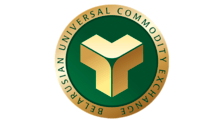Belarusian Universal Commodity Exchange
 | |
Native name | Белорусская универсальная товарная биржа (БУТБ) |
|---|---|
| Commodities exchange | |
| Founded | 2004 |
| Headquarters | Minsk, Belarus |
| Website | www.butb.by |
The Belarusian Universal Commodity Exchange (BUCE) (full name: Open Joint-Stock Company Belarusian Universal Commodity Exchange) is the only commodity exchange in the Republic of Belarus and one of the largest in Eastern Europe. The BUCE is an open joint-stock company with the controlling stake (98%) owned by the government.
Founded in 2004, the BUCE now has over 19,000 registered members from 60 countries, including 4000 foreign companies. The BUCE head office is located in Minsk with branches in all five of the country's regional centers: Brest, Gomel, Grodno, Mogilev and Vitebsk. The BUCE also has an office in Russia and exchange brokers in Latvia, Lithuania, Kazakhstan, Poland,Turkey, and Ukraine.
History
The Belarusian Universal Commodity Exchange was incorporated on May 25, 2004. The BUCE was created under the initiative of the country’s president, Alexander Lukashenko, by Council of Ministers Resolution No. 1719 of 30 December 2003.[1]
The first trading session, to sell timber, took place on June 2, 2005; the trade in metal products began on June 29, 2005. In Q4 2005 the commodity exchange started preparing to sell agricultural products, and launched garicultural sales in January 2006.
In May 2009, an online trading platform for industrial and consumer goods was launched. It enabled buy-and-sell transactions to be executed at all horus via the Internet.
In December 2010, the BUCE was authorized to hold electronic auctions under government procurement contracts.[2]
In November 2012, the BUCE started trading derivatives.
Administration
The BUCE is operating under direct supervision of a Board of Directors chaired by Arkady Salikov. In between general meetings of shareholders the BUCE is managed by the Supervisory Board headed by First Deputy Minister of Antitrust Regulation and Trade of the Republic of Belarus. He is the government’s representative in the commodity exchange. Following the relevant resolution of the Council of Ministers, a Coordinating Council for Exchange Trade led by Vice Premier of Belarus Vladimir Semashko was set up.[3] The Council consists of the heads of Belarus’ key ministries.
Objectives and functions
The BUCE's objectives:[4]
- improving the mechanism of government regulation in domestic and foreign trade;
- developing a formal wholesale market;
- providing equal access to the market;
- offering additional economic incentives to market agents;
- assisting the development of an organized commodity market;
- increasing the efficiency of the Belarusian export;
- simplifying the search for sellers and buyers;
- creating a trading mechanism that allows for transparent execution of transactions on the commodity exchange.
The BUCE's functions:
- creating conditions for carrying out exchange auctions;
- conducting exchange auctions;
- registering transactions at the exchange;
- arranging quality inspection of the exchange goods;
- identifying the supply and demand for various goods.
Key business areas
- Electronic trade in metals and articles thereof;
- Electronic trade in timber and articles thereof;
- Electronic trade in agricultural products;
- Electronic trade in industrial and consumer products;
- Electronic procurement;
- Electronic property trading;
- Trade logistics;
- Arbitration;
- Publishing.
Structure and product range
The BUCE consists of four sections:
- Metals and articles thereof;
- Timber and articles thereof;
- Agricultural products;
- Industrial and consumer goods.
These sections conduct trading sessions to sell a wide range of commodity items. The major ones are ferrous and non-ferrous metals and articles made thereof, scrap metal and metal byproducts, coal, coke, cables and wires (metal products section), standing timber, round timber, timber, plywood and flake boards, paper and pasteboard (timber products section), hard cheese, milk powder, casein, butter, rapeseed oil, sunflower and soy oil cakes, rawhides (agricultural products section), industrial machinery, electronics, etc. (industrial and consumer products section).[5] Every day the BUCE hosts five to seven trading sessions.[6]
Futures market
The BUCE's futures market section is currently suspended. Three futures contracts were available for trading - a futures contract for hot rolled steel coils, a futures contract for steel bars and a futures contract for petroleum products price index (calculated by Saint-Petersburg International Mercantile Exchange). Trade statistics are regularly published on the BUCE website.[7]
International relations
The BUCE is a member of several international organizations. In 2008 it joined the International Association of Exchanges of the CIS (IAE CIS),[8] and in 2011 it acceded to the Association of Futures Markets (AFM).[9] The BUCE also maintains partner relations with Moscow Interbank Currency Exchange, Moscow Stock Exchange, Uzbek Commodity Exchange, Kiev Agronomic Industry Exchange, the Russian Union of Metal and Steel Suppliers, etc.
References
- ↑ "Постановление Совета Министров Республики Беларусь". Национальный правовой интернет-портал Республики Беларусь (in Belarusian). Retrieved 31 October 2013.
- ↑ "Постановление Совета Министров. Республики Беларусь от 31.12.2010 № 1923" (PDF). Official website of the Belarusian Government. Retrieved 8 April 2014.
- ↑ "Постановление совета министров Республики Беларусь от 6 августа 2009 г. №1039 "О некоторых мерах по реализации закона Республики Беларусь "О товарных биржах"". Национальный правовой интернет-портал Республики Беларусь. Retrieved 1 November 2013.
- ↑ "About the Exchange: Aims&Functions". Official website of the Belarusian Universal Commodity Exchange. Retrieved 1 November 2013.
- ↑ Зарецкий, Анатолий (2012). "Биржевая товарная торговля: мода или веление времени? Белорусский опыт". Рынок ценных бумаг. Retrieved 1 November 2013.
- ↑ Короленок, Светлана (2012). "Интеграция рынка металлопродукции через биржевые механизмы: успех гарантирован" (PDF). Знак качества (in Russian). Retrieved 17 December 2013.
- ↑ "Объем фьючерсных контрактов на БУТБ в 2012 году составил Br2,3 млрд". БЕЛТА. 2013-02-17. Archived from the original on 17 May 2014. Retrieved 1 November 2013.
- ↑ "IAE CIS members list". IAE CIS website. Retrieved 8 April 2014.
- ↑ "AFM members directory". AFM website. Retrieved 8 April 2014.